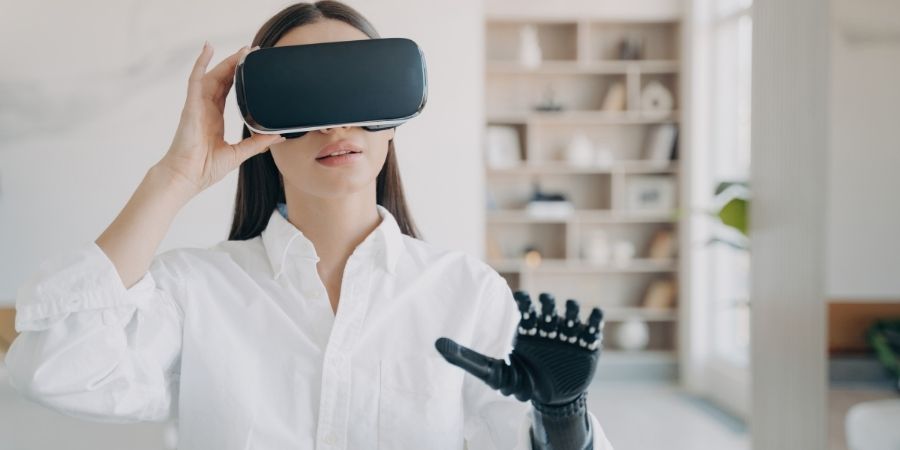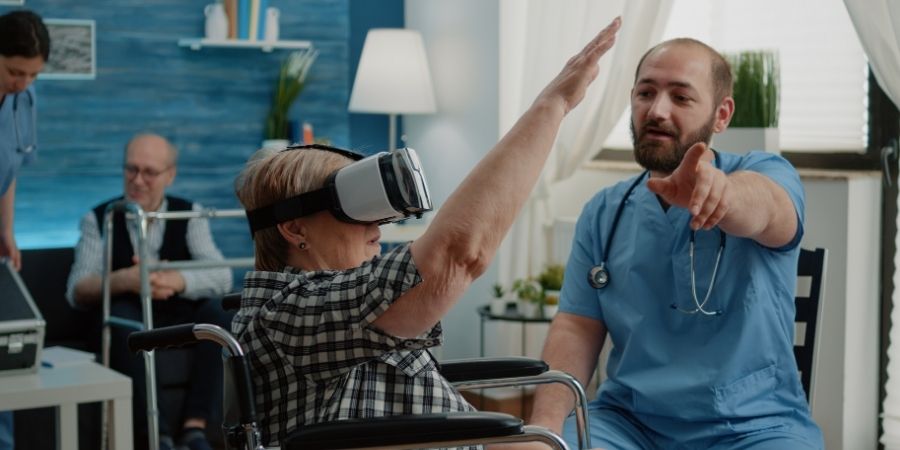- About
- SERVIZI
- INDUSTRIES
- Scienza e
Salute - Fashion & Retail
- Nature &
Agriculture - Manufacturing & Logistics
- Hotellerie &
Real Estate - Bellezza, Sport e
Benessere
- Scienza e
- News
- CONTATTI

In the realm of increasingly advanced uses of robotics, there is a growing discussion about the integration of augmented reality (AR) and virtual reality (VR) in various fields, including healthcare, particularly in the context of aging, the treatment of degenerative diseases, and entertainment. These technologies are revolutionizing the way we approach health and wellness, offering innovative solutions that were once thought impossible.
For instance, AR and VR can be used to create immersive environments that help elderly individuals maintain cognitive function and physical activity, thereby improving their quality of life. In the treatment of degenerative diseases, such as Parkinson’s or Alzheimer’s, these technologies can provide patients with engaging and interactive therapies that stimulate brain activity and slow disease progression.
Moreover, in the entertainment sector, AR and VR offer new ways for people to experience games and media, making them more interactive and engaging. This not only provides entertainment but also has potential therapeutic benefits, such as reducing stress and improving mental health.
The concept of “tech for health” is becoming increasingly important as we look for ways to leverage technology to improve healthcare outcomes.
The global population is aging rapidly, with projections indicating a significant increase by 2050. This demographic shift necessitates a move towards preventive healthcare and educational strategies, particularly for age-related visual impairments such as cataracts and age-related macular degeneration (AMD). Traditional educational methods often fall short of effectively raising awareness among the elderly. Gerontechnology, especially through various uses of robotics and augmented reality (AR), offers innovative solutions by enhancing visual experiences and education. AR can simulate visual disorders, providing an interactive learning platform that could improve seniors’ understanding of eye health.
A recent paper, “The Interactive Use of Augmented Reality for Educating the Elderly on Common Age-Related Eye Diseases,” published in BMC Geriatrics, highlighted the significant benefits of AR technology in health education for the elderly. An AR-based educational workshop was developed to help seniors comprehend the major visual symptoms of several eye diseases and experience the challenges faced by visually impaired individuals.
This study demonstrated the potential of AR technology in facilitating health education on eye diseases among the elderly. Further research is needed to explore the specific backgrounds and characteristics of target participants and to integrate AR with other pedagogical approaches. Such efforts could maximize the impact of AR-based workshops in health education across broader healthcare contexts.

Recent studies are exploring the transformative potential of virtual reality (VR) for seniors. Retired Army Col. Farrell Patrick, a former computer science professor, recently experienced VR for the first time at John Knox Village, a retirement community in Florida. This experience is part of a Stanford University study involving 17 senior communities, which found that VR significantly improved the emotional well-being and social interactions of seniors aged 65 to 103. Conducted in collaboration with Mynd Immersive, the study revealed that nearly 80% of participants reported a more positive attitude after VR sessions, and 60% felt less socially isolated. Caregivers also observed improved moods in 75% of residents, with over 80% of residents and 95% of caregivers noting that discussing VR experiences enhanced their relationships.
VR offers seniors immersive experiences, such as flying in a fighter jet or visiting Paris, which can evoke memories and stimulate conversations. It is particularly beneficial for those with dementia, as it helps spur memories and interactions with caregivers.
The study suggests that VR could become a valuable tool for senior care, with future improvements making it more accessible and realistic. As VR technology evolves, it promises to offer seniors enriching experiences that improve their quality of life and foster social connections.
At Singapore Polytechnic’s recent open house, students presented a range of innovative projects that focused on virtual reality (VR) solutions for the elderly and sustainability initiatives. A standout project was the “Steady Lah” app, created by students from the School of Electrical and Electronic Engineering. This app leverages VR to aid seniors in physical rehabilitation by offering 16 VR games that test mobility, memory, motor, and cognitive skills. By providing a game-based environment, the app motivates seniors to engage in their rehabilitation. It also uses artificial intelligence to analyze user progress and recommend suitable games, thereby enhancing the rehabilitation experience. The app received positive feedback, with 63% of users preferring it over traditional rehabilitation routines. The team plans to expand the app to include 52 games, allowing seniors to try a new game each week.
In addition to virtual reality solutions, service robots designed to assist the elderly with their daily activities are being increasingly adopted. These robots not only provide support in areas such as medication reminders and mobility assistance but also integrate virtual reality to enhance their functionality. Equipped with advanced sensors and artificial intelligence, they can navigate home environments and offer companionship, significantly improving the quality of life for seniors.
Augmented reality (AR) and virtual reality (VR) are impacting the healthcare sector, transforming a range of areas from surgical training to mental health care. These cutting-edge technologies offer unprecedented precision and connectivity. In surgical training, AR and VR provide hyper-realistic simulations, allowing surgeons to hone their skills without the traditional risks associated with practice. AR enhances surgical procedures with real-time 3D overlays, offering improved anatomical insights and better patient outcomes.
In diagnostics, AR and VR transform 2D imaging into interactive 3D visualizations, helping healthcare professionals make accurate diagnoses and develop personalized treatment plans. They also facilitate remote patient monitoring, eliminating geographical barriers and ensuring continuous care. In mental health, AR and VR introduce innovative therapies for conditions such as depression and addiction, providing safe environments for exploration and treatment.
Amidst these advancements, robotics is also expanding in healthcare. It complements AR and VR by automating tasks and enhancing precision in various medical procedures. Innovations such as robotic nurses are crucial in improving patient care and operational efficiency. Despite challenges like data privacy and technological disparities, the potential benefits of AR and VR in healthcare are immense. As the healthcare sector embraces these innovations, the future looks increasingly promising.
Per maggiori informazioni sulla STH e i suoi servizi o per possibili collaborazioni, il nostro team è a tua disposizione.
Compila il modulo o inviaci una mail per discutere di come possiamo lavorare insieme.
